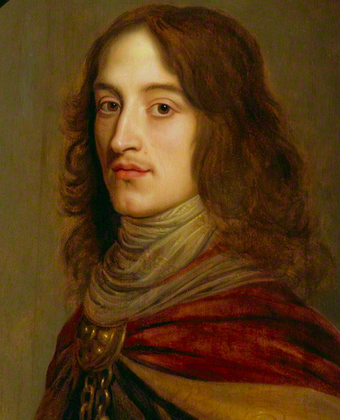Annotation:Prince Rupert's March: Difference between revisions
No edit summary |
No edit summary |
||
| (5 intermediate revisions by 2 users not shown) | |||
| Line 1: | Line 1: | ||
---------- | |||
---- | {{TuneAnnotation | ||
|f_tune_annotation_title=https://tunearch.org/wiki/Annotation:Prince_Rupert's_March > | |||
'''PRINCE RUPERT'S MARCH.''' AKA - "Prins Robbert Masco." English, Country Dance Tune (4/4 time). A Minor (Sharp). Standard tuning (fiddle). AAB (Chappell): ABB (Sharp). The air can be found in manuscript form in '''Elizabeth Rogers' Virginal Book'''. It was published by John Playford in his '''English Dancing Master''' [http://www.izaak.unh.edu/nhltmd/indexes/dancingmaster/Dance/Play1065.htm] (1650-1, and all subsequent editions, through the 18th and final edition of 1728), with the exception of the second and third editions of 1652 and 1657. Playford had Royalist sympathies, but his inclusion of a march honoring a Cavalier hero was a challenge to the Protectorate government then in power. He may have received | |f_annotation='''PRINCE RUPERT'S MARCH.''' AKA - "Prins Robbert Masco." English, Country Dance Tune (4/4 time). A Minor (Sharp). Standard tuning (fiddle). AAB (Chappell): ABB (Sharp). The air can be found in manuscript form in '''Elizabeth Rogers' Virginal Book'''. It was published by John Playford in his '''English Dancing Master''' [http://www.izaak.unh.edu/nhltmd/indexes/dancingmaster/Dance/Play1065.htm] (1650-1, and all subsequent editions, through the 18th and final edition of 1728), with the exception of the second and third editions of 1652 and 1657. Playford had Royalist sympathies, but his inclusion of a march honoring a Cavalier hero, noted strategist and nephew of Charles I was a challenge to the Protectorate government then in power. He may have received wise counsel to drop the tune/dance from the '''Dancing Master''', until after the death of Cromwell in 1658. It was one of only two pieces removed from the first edition to the second, which was issued a year later. Music publishers on the Continent were under no such constraints, and "Prince Rupert's March" was published '''Bellerophon''' (Gesangh der Zeeden, 1648, with words), and in blind recorder virtuoso Jacob van Eyck's '''Der Fluyten Lusthof''' (1649, as "Prins Robbert Masco"). Chappell (1858) points out the march resembles "[[British Grenadiers (The)]]," albeit in minor instead of major key, but any piece honoring the Grenadiers necessarily is no older than 1682, when that unit was formed. [[File:rupert.png|340px|thumb|left|Prince Rupert (1619-1682)]] | ||
<br> | <br> | ||
<br> | <br> | ||
Prince Rupert [https://en.wikipedia.org/wiki/Prince_Rupert_of_the_Rhine] (1619-82) was the son of the Elector Palatine and was King Charles I’s nephew. He became the archetypal Cavalier of the English Civil War and ultimately the senior Royalist general, commanding the Royalists at the battle of Edgehill, in 1642. Rupert was discoverer of ''mezzotinto'', the hint of which he is said to have taken from seeing a soldier scraping his rusty musket. The first mezzotinto print ever published was the work of his hands, and may be seen in the first edition of Evelyn's '''Scidtura.''' When he died he was interred with great magnificence in Henry the Seventh's Chapel, Westminster Abbey, in 1682. Playford's march for Rupert may have originated in Davenport’s masque '''Triumphs of the Prince d’Amour''' (1636), which was an entertainment for Prince Rupert and his brother, Prince Charles<ref>Keith Whitlock, “John Playford’s English Dancing Master 1650/51 as Cultural Politics”, '''Folk Music Journal''', vol. 7, No. 5, 1999, p. 569. </ref>. | |||
Prince Rupert [https://en.wikipedia.org/wiki/Prince_Rupert_of_the_Rhine] became the archetypal Cavalier of the English Civil War and ultimately the senior Royalist general, commanding the Royalists at the battle of Edgehill, in 1642. | |f_source_for_notated_version= | ||
< | |f_printed_sources=Barlow ('''The Complete Country Dances from Playford's Dancing Master'''), 1985; No. 81, p. 33. Chappell ('''Popular Music of the Olden Time, vol. 1'''), 1859; p. 317. Raven ('''English Country Dance Tunes'''), 1984; p. 43 (a facsimile copy of the Playford original). Sharp ('''Country Dance Tunes'''), 1994; p. 46. | ||
|f_recorded_sources= | |||
|f_see_also_listing= | |||
}} | |||
'' | ------------- | ||
</ | |||
---- | |||
Latest revision as of 14:37, 22 August 2023
X: 1 T:Prince Rupert's March. (p)1651.PLFD.081 M:C L:1/8 Q:1/2=100 S:Playford, Dancing Master,1st Ed.,1651. O:England H:1651. Z:Chris Partington. K:Ddor d2|d2A2 d2 e2|f3 g f2 f2|e2 d2 d2 ^c2|d6:| |:d2|e3 d ef g2|c3 d c2 c2|f2 f2 gaga|f6 f2| e3 d ef g2|c3 d c2 f2|e2 d2 d2 ^c2|d6:|

Prince Rupert [2] (1619-82) was the son of the Elector Palatine and was King Charles I’s nephew. He became the archetypal Cavalier of the English Civil War and ultimately the senior Royalist general, commanding the Royalists at the battle of Edgehill, in 1642. Rupert was discoverer of mezzotinto, the hint of which he is said to have taken from seeing a soldier scraping his rusty musket. The first mezzotinto print ever published was the work of his hands, and may be seen in the first edition of Evelyn's Scidtura. When he died he was interred with great magnificence in Henry the Seventh's Chapel, Westminster Abbey, in 1682. Playford's march for Rupert may have originated in Davenport’s masque Triumphs of the Prince d’Amour (1636), which was an entertainment for Prince Rupert and his brother, Prince Charles[1].
- ↑ Keith Whitlock, “John Playford’s English Dancing Master 1650/51 as Cultural Politics”, Folk Music Journal, vol. 7, No. 5, 1999, p. 569.

